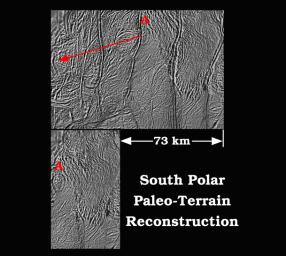
|
Ancient Terrain on Enceladus
- Click the image above for a larger view
- Full-Res JPEG (2442 x 2189) (608.9 kB)
- Full-Res TIFF (2442 x 2189) (16.1 MB)
Caption:
This figure shows a possible history of the south polar terrain on Saturn's moon Enceladus.
The top figure is a digital map that shows the four major "tiger stripe" fractures and the ropey terrain between them near the south pole of Enceladus. The data were acquired by NASA's Cassini spacecraft, imaging science sub-system during four close-targeted flybys of Enceladus in March, August and October 2008.
Cassini scientists have recently inferred that tectonic spreading, somewhat like tectonic sea-floor spreading on Earth, occurs between and along the tiger stripes. However, unlike sea-floor spreading on Earth, where upwelling hot magma fills the central rift of a spreading ridge as the ridge spreads symmetrically to either side of the rift, on Enceladus the spreading is asymmetric. Like a conveyor belt, newly created icy crust on Enceladus spreads out asymmetrically (i.e., in one direction) relative to the tiger stripes.
It appears that a broad zone of spreading pushes from the western hemisphere side of the south polar terrain region (left side of the top panel) to the eastern side of the region (right side of the top panel). The map in the top panel is about 110 kilometers (68 miles) wide. If the tiger stripes and much of the surrounding terrain are snipped out of the map along the right tectonic contacts, the remaining sections can be pieced back together like a jigsaw puzzle. The reassembled puzzle shows what the tiger stripe region might have looked like long ago before much spreading took place.
The bottom panel shows the reconstruction of a possible paleo-terrain that may have existed early in the geological history of the south polar region. This reconstruction indicates that at least 73 kilometers (45 miles) of spreading may have occurred over time. After the reconstruction, a curious elliptical ring-shaped feature appears along the left edge at about the location where the spreading seems to have originated. A wavy pattern of ropey terrain deflects around the elliptical feature. Imaging scientists have speculated that perhaps this is a relict impact feature or the surface expression of a warm, rising diapir (convective cell) that may drive the spreading through convection, much the same way that convection drives plate tectonics on Earth.
Background Info:
The Cassini-Huygens mission is a cooperative project of NASA, the European Space Agency and the Italian Space Agency. The Jet Propulsion Laboratory, a division of the California Institute of Technology in Pasadena, manages the mission for NASA's Science Mission Directorate, Washington, D.C. The Cassini orbiter and its two onboard cameras were designed, developed and assembled at JPL. The imaging operations center is based at the Space Science Institute in Boulder, Colo.
For more information about the Cassini-Huygens mission visit http://saturn.jpl.nasa.gov/ . The Cassini imaging team homepage is at http://ciclops.org .
Cataloging Keywords:
| Name | Value | Additional Values |
|---|---|---|
| Target | Enceladus | |
| System | Saturn | |
| Target Type | Satellite | |
| Mission | Cassini-Huygens | |
| Instrument Host | Cassini Orbiter | |
| Host Type | Orbiter | |
| Instrument | Imaging Science Subsystem (ISS) | |
| Detector | ||
| Extra Keywords | Color, Impact, Map | |
| Acquisition Date | ||
| Release Date | 2008-12-15 | |
| Date in Caption | ||
| Image Credit | NASA/JPL/Space Science Institute | |
| Source | photojournal.jpl.nasa.gov/catalog/PIA11140 | |
| Identifier | PIA11140 | |
